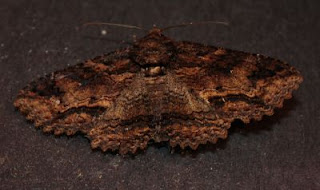Forewing: 10mm
Also reported in Zones 3,5,6
While superficially similar to last weeks Yellow-collared Scape Moth, this moth is about half the size and holds its wings away from the body while resting.
Desmia Complex
Forewing 12mm
There are two species represented in this complex; D. funeralis and D. maculalis. At one time white scales on the head were thought to differentiate the two, but that is currently in dispute. All of my sources say that the two cannot be distinguished from a photograph.
Obtuse Euchlaena - Euchlaena obtusaria (#6726)
Forewing: 25mm
The deeply serrated hindwing and dark marks near the tip of the forewing are diagnostic for this species.
Ailanthus Webworm Moth - Atteva aurea (#2401)
Forewing: 12mm
Also reported in Zones 1,2,3,4,5,6
This unique moth can often be found nectaring during the day; I have found them frequently on Goldenrods.
Faint-spotted Palthis - Palthis asopialis (#8398)
Forewing: 12mm
Also reported in Zones 3,6
Maple Callous Borer - Synanthedon acerni (#2554)
Forewing:
Also reported in Zone 6
This little moth has a strong and direct flight, moving back and forth while hovering much like a hummingbird, but with the little fringe on its tail it looks more like a flying shrimp.
Blinded Sphinx - Paonias excaecata (#7824)
Forewing: 35mm
































